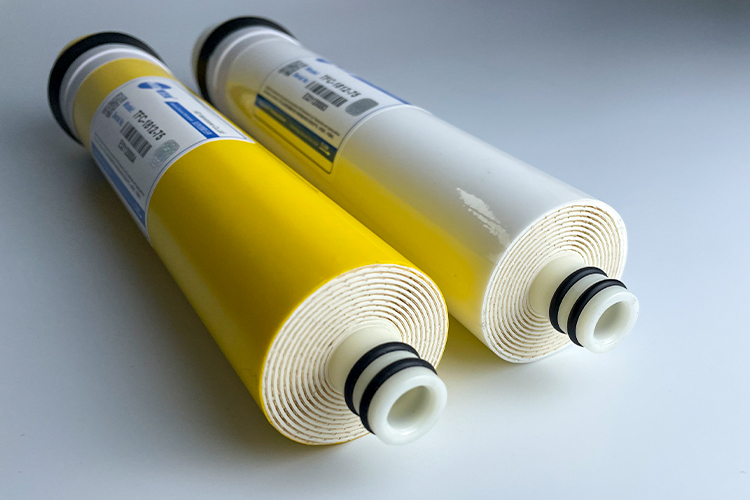Why the new RO Membrane Not Working? Let’s talk about the reasons and solutions below:
1. The inlet water temperature is too low:
The standard working temperature of the reverse osmosis membrane is 25℃, and the water production will decrease by 3% every time the temperature drops by one degree. If the temperature is lower than 0°C, the raw water freezes and naturally cannot produce water normally.
2. The inlet water pressure is too low:
The working principle of reverse osmosis membrane is to filter by pressure. If the booster pump is used for too long, the inlet pressure drops, and the raw water cannot meet the requirements, resulting in no water out of the reverse osmosis system. Usually, the working pressure of the reverse osmosis membrane needs to reach 4.14MPA.
3. Influent pH
Various RO membrane modules have an allowable pH range, and the pH of the influent water has almost no effect on tater production. But even within the allowable range, it has a greater impact on the salt rejection rate. On the one hand, the pH value also has a certain impact on the conductivity of the product water. This is because the reverse osmosis membrane itself mostly contains some active groups, and the pH value can affect the membrane. The electric field on the surface in turn affects the migration of ions. The pH value has a direct effect on the form of impurities in the influent. For example, for dissociable organics, the rejection rate decreases with the decrease of pH. On the other hand, because the dissolved CO2 in water is greatly affected by the pH value, when the pH value is low, it exists in the form of gaseous CO2 and easily penetrates the reverse osmosis membrane. Therefore, the salt rejection rate is lower when the pH value is low. As the pH increases, the gaseous CO2 is converted For HCO-3 and CO2-3 ions, the salt rejection rate is gradually increasing, and the salt rejection rate reaches the highest between pH 7.5 and 8.5.
4. Influent salt concentration
Osmotic pressure is a function of the concentration of salt or organic matter in the water. The higher the salt content, the osmotic pressure increases. When the inlet pressure remains the same, the net pressure will decrease and the water production will decrease. The salt permeability is proportional to the salt concentration difference between the front and back of the membrane. The higher the salt content of the influent, the greater the concentration difference, and the salt permeability increases, which leads to a decrease in the salt rejection rate. For the same system, the feed water salt content is different, the operating pressure and the product water conductivity are also different. For every increase of the feed water salt content by 100 ppm, the inlet water pressure needs to increase by about 0.007 MPa. At the same time, due to the increase in concentration, the product water conductivity Also increased accordingly.
5. Pretreatment blockage:
Reverse osmosis membranes have relatively high requirements for water intake, and appropriate pretreatment devices, such as quartz sand filters, security filters, etc., are usually added before the membrane elements. If it is used for a long time, the pretreatment device may be blocked due to excessive impurities. After the blockage, there will be a certain drop in water production. When the pretreatment impurities are completely blocked, the raw water cannot enter the reverse osmosis membrane through the pretreatment, then the reverse osmosis The membrane will appear so-called no water.
6. The check valve is blocked:
During use, the check valve may also be blocked by impurities. You can take the check valve out to check whether the water production of the system has increased significantly. Usually, the chance of check valve blockage is relatively small.
7. The reverse osmosis membrane is blocked by impurities:
In addition to pretreatment may be blocked, reverse osmosis membranes may also be blocked. The raw water contains a lot of impurities. Usually the pretreatment device can filter most of the impurities to make the influent water meet the standard requirements of reverse osmosis. However, some pretreatment systems are designed unreasonably, resulting in impurities such as organic matter, free chlorine, and suspended solids. Into the inside of the membrane element, causing blockage of the membrane element. When impurities completely block the membrane pore size, there will be no water production.
8. The post-filter system is blocked:
In the process of use, appropriate protective measures are usually added behind the reverse osmosis membrane to protect the product water from being affected by other factors, such as activated carbon filtration, precision filtration, etc. These devices may be blocked by the filter material and also affect the reverse osmosis of the water production of the system.
Solution:
1. The pretreatment device contains a large number of filter materials, which need to be replaced and cleaned regularly, which can effectively prevent the pretreatment device from blocked.
2. After the reverse osmosis membrane is blocked, it is usually recommended to use chemical cleaning to remove impurities inside the membrane element, which can effectively restore the filtration performance of the membrane element. And optimize the pretreatment system.
3. The low pressure of the raw water is usually caused by the aging of the booster pump, just replace the booster pump.
4. After the check valve is blocked, it needs to be cleaned with clean water and cleaned before it can be put into use. If it cannot be cleaned, the check valve needs to be replaced.
5. Appropriate insulation measures should be taken when using reverse osmosis membranes in winter.
6. When the post-filter system is put into the filter material, a certain space should be reserved to prevent too much filter material from blocking the system.

Post time: Mar-19-2021




